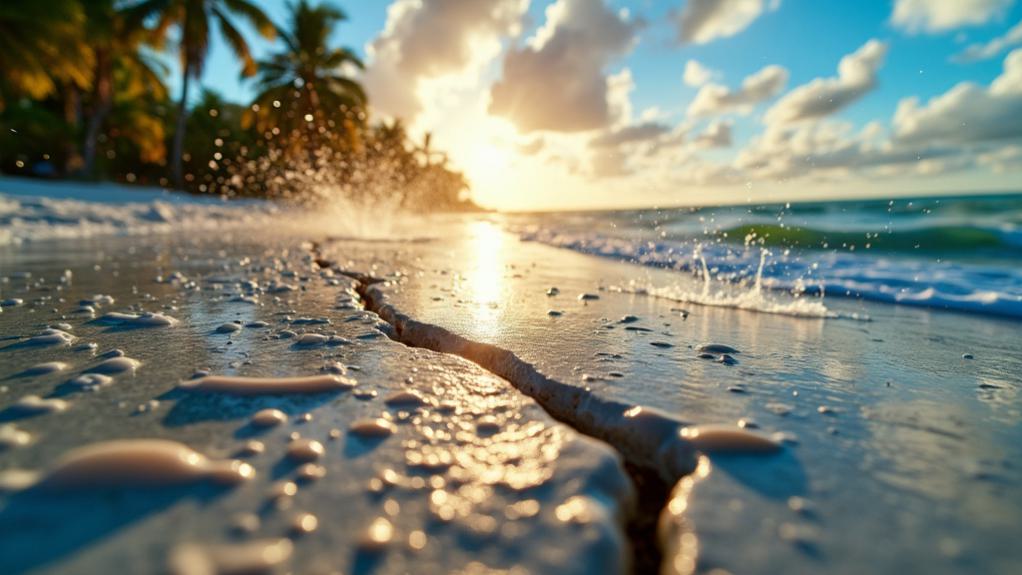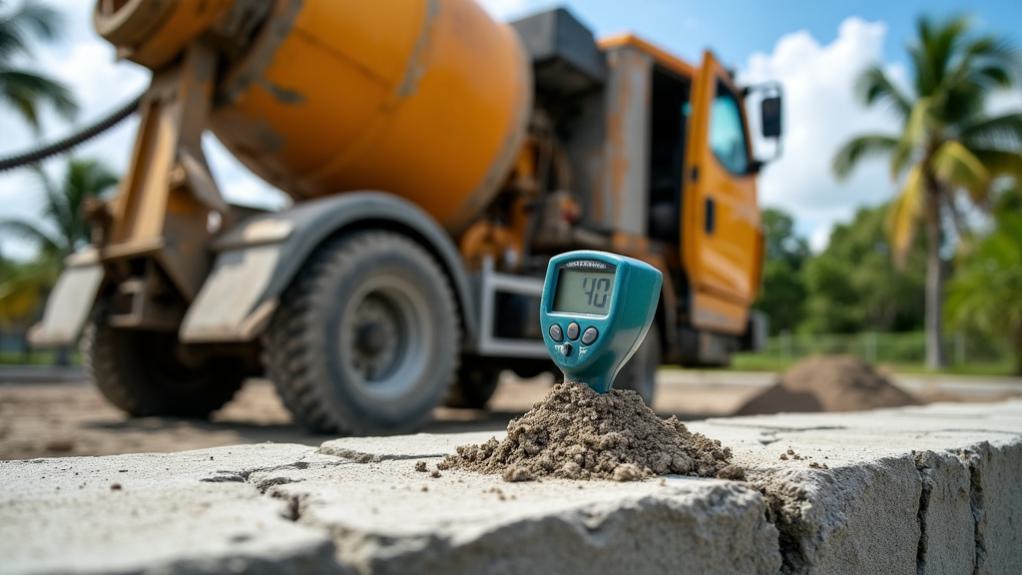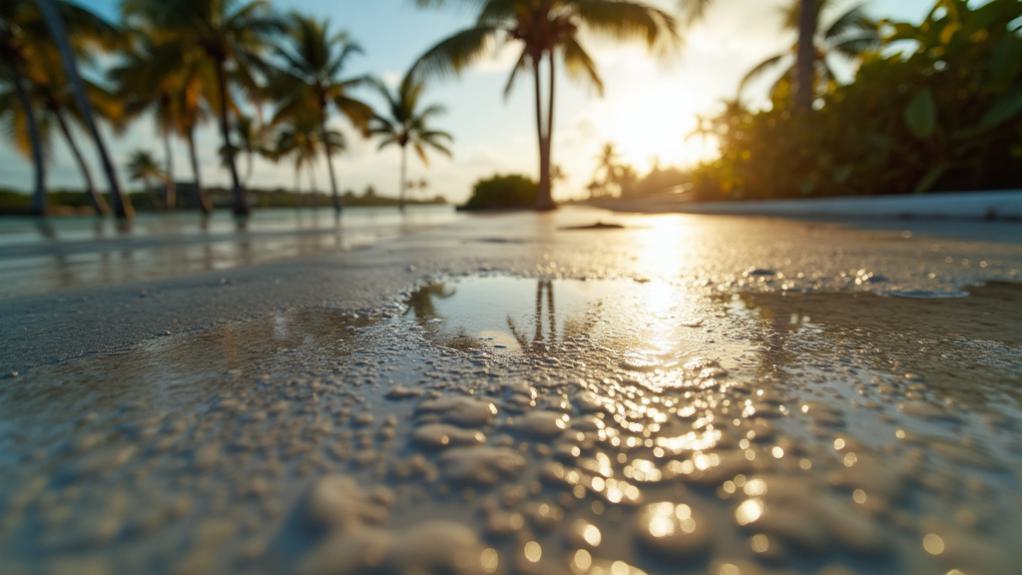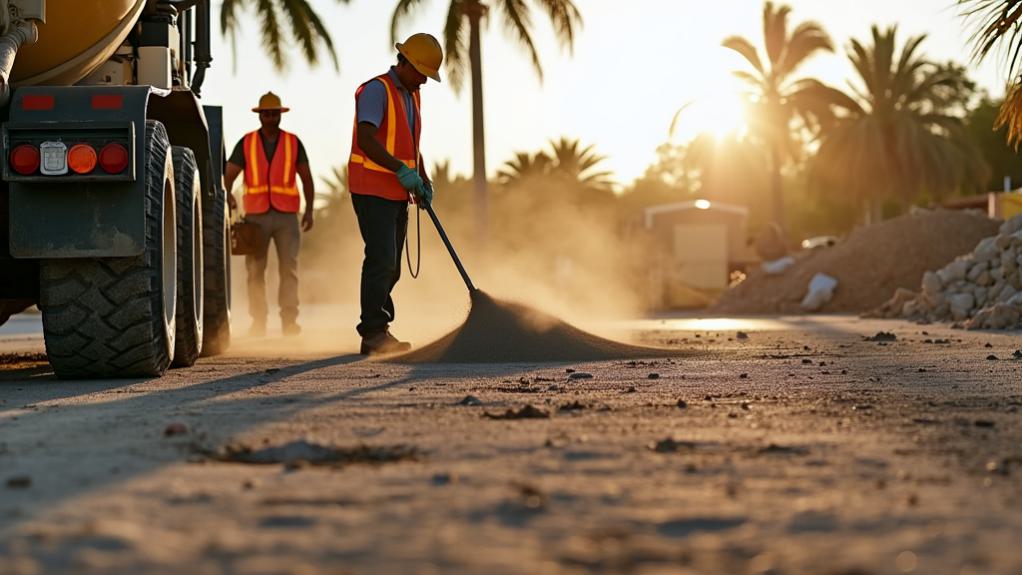Selecting the optimal concrete mix for Florida’s climate requires addressing unique environmental challenges. Key considerations include high humidity, heat, and salt exposure in coastal areas. A water-cement ratio between 0.40 and 0.50 balances strength and workability. Heat-resistant and moisture-tolerant aggregates, such as crushed limestone and lightweight expanded clay, enhance durability. Admixtures like water reducers and corrosion inhibitors improve performance. Salt-resistant mixes incorporate supplementary cementitious materials and polymer-modified binders. Specialized designs mitigate heat and humidity issues. Rigorous testing, including compressive strength and chloride ion penetration resistance, ensures mix effectiveness. Tailoring concrete mixes to Florida’s specific conditions maximizes longevity and structural integrity.
Florida’s Unique Climate Challenges

Florida’s distinctive climate poses numerous challenges for concrete construction. The state’s subtropical environment, characterized by high temperatures, elevated humidity levels, and frequent precipitation, creates unique conditions that significantly impact concrete performance and durability. These factors must be carefully considered when selecting an appropriate concrete mix for projects in the region.
Humidity effects play a crucial role in concrete curing and long-term stability. The high moisture content in the air can lead to increased water absorption in the concrete mixture, potentially affecting its strength and durability. Additionally, the elevated humidity can slow down the evaporation process, prolonging curing times and increasing the risk of surface defects.
Temperature fluctuations, particularly the extreme heat often experienced in Florida, can accelerate the hydration process and cause rapid moisture loss. This can result in thermal cracking, reduced workability, and compromised structural integrity.
The combination of high temperatures and humidity also promotes the growth of mold and mildew, which can deteriorate concrete surfaces over time. To address these challenges, engineers and contractors must carefully select concrete mixes that incorporate appropriate admixtures, aggregates, and cement types to enhance resistance to Florida’s harsh climate conditions.
Key Concrete Mix Components
The primary components of a concrete mix are cement and aggregates, which form the structural backbone of the material.
The water-cement ratio is a critical factor that influences the strength, durability, and workability of the concrete.
Balancing these key elements is essential for achieving the desired performance characteristics in various applications and environmental conditions.
Cement and Aggregates
Comprising the foundation of any concrete mix, cement and aggregates play crucial roles in determining the strength, durability, and workability of the final product. In Florida’s climate, selecting the appropriate cement type is paramount. Portland cement Type I or II is commonly used for general construction, while Type III is preferred for projects requiring rapid strength development. Type V cement offers enhanced sulfate resistance, crucial for coastal areas exposed to seawater.
Aggregate selection is equally important, with sizes ranging from fine sand to coarse gravel. In Florida, limestone aggregates are prevalent due to their local availability and compatibility with the region’s geology.
The proportion of fine to coarse aggregates significantly influences concrete properties, affecting workability, strength, and shrinkage characteristics. Fine aggregates, typically sand, fill voids between larger particles, while coarse aggregates provide bulk and strength.
The maximum aggregate size is generally limited to one-third of the concrete member’s thickness or three-quarters of the minimum clear spacing between reinforcing bars. Proper gradation of aggregate sizes ensures optimal packing density, reducing cement paste requirements and improving concrete performance in Florida’s challenging environmental conditions.
Water-Cement Ratio
While cement and aggregates form the structural backbone of concrete, the water-cement ratio emerges as a critical factor in determining its final properties. This ratio, expressed as the mass of water divided by the mass of cement, significantly influences the concrete’s strength, durability, and workability. In Florida’s humid climate, carefully controlling this ratio is essential to achieve optimal performance.
A lower water-cement ratio typically results in higher-strength concrete with improved durability and reduced permeability. However, it also decreases workability, making the mix more challenging to place and finish. Conversely, a higher ratio enhances workability but may compromise strength and durability. The ideal ratio depends on the specific application and environmental conditions.
In Florida’s moisture-rich environment, the water-cement ratio must be precisely balanced to account for potential water absorption from the atmosphere and to maintain hydration efficiency. Excess water can lead to increased porosity and reduced strength, while insufficient water may impede proper curing.
Admixtures and supplementary cementitious materials can be employed to fine-tune the water-cement ratio, allowing for optimized concrete performance in Florida’s unique climate conditions.
Water-to-Cement Ratio Considerations

At the core of concrete mix design lies the crucial concept of water-to-cement ratio (w/c ratio). This fundamental parameter significantly influences the strength, durability, and performance of concrete in Florida’s challenging climate. A lower w/c ratio generally results in higher strength and improved durability, but it can also affect workability and mix consistency.
In Florida’s hot and humid environment, careful consideration of the w/c ratio is essential for optimal concrete performance. Higher ratios may lead to increased water retention, potentially compromising the concrete’s structural integrity and resistance to weathering. Conversely, excessively low ratios can hinder proper hydration and workability, particularly in the state’s warm temperatures.
Achieving the ideal w/c ratio requires balancing multiple factors, including cement type, aggregate properties, and desired strength characteristics. For Florida’s climate, a w/c ratio typically ranging from 0.40 to 0.50 is often recommended, depending on specific project requirements.
This range generally provides an optimal balance between strength, durability, and workability. However, precise ratios should be determined through laboratory testing and adjusted based on local conditions and project specifications to ensure the concrete mix’s suitability for Florida’s unique environmental challenges.
Aggregates for Florida Conditions
When selecting aggregates for concrete mixes in Florida, several environmental factors must be considered.
Heat-resistant, moisture-tolerant, and salt-resistant aggregate options are crucial for ensuring concrete durability in the state’s unique climate.
These specialized aggregates contribute to the longevity and performance of concrete structures exposed to Florida’s high temperatures, humidity, and coastal conditions.
Heat-Resistant Aggregate Options
Florida’s subtropical climate demands concrete mixes that can withstand high temperatures and humidity. When selecting heat-resistant aggregate options, contractors and engineers must consider materials that offer superior thermal insulation properties and compatibility with reflective coatings.
Lightweight expanded clay aggregates (LECA) are an excellent choice, as they provide enhanced thermal resistance while reducing the overall weight of the concrete structure.
Another viable option is crushed limestone, which exhibits low thermal expansion and high heat capacity. This aggregate type helps stabilize concrete temperature fluctuations, reducing the risk of thermal cracking.
Quartzite aggregates, known for their durability and heat resistance, can also be incorporated into mixes designed for Florida’s climate.
For optimal heat resistance, incorporating ceramic-based aggregates or synthetic materials like expanded glass beads can significantly improve the concrete’s thermal performance. These materials offer excellent insulation properties and can be combined with traditional aggregates to achieve desired strength and workability characteristics.
When selecting heat-resistant aggregates, it is crucial to consider their compatibility with admixtures and supplementary cementitious materials to ensure optimal performance in Florida’s challenging environmental conditions.
Moisture-Tolerant Aggregate Selection
While heat resistance is a key factor in Florida’s concrete applications, moisture tolerance plays an equally important role in aggregate selection. The state’s high humidity and frequent rainfall necessitate the use of aggregates that can withstand prolonged exposure to moisture without compromising structural integrity or promoting deterioration.
Moisture-tolerant aggregate types suitable for Florida’s climate include crushed limestone, granite, and certain types of gravel. These materials exhibit low porosity and minimal moisture retention, reducing the risk of water absorption and subsequent expansion or contraction. Limestone, in particular, is abundant in Florida and offers excellent moisture resistance while maintaining good bonding properties with cement paste.
When selecting aggregates, it is crucial to consider their water absorption rates and susceptibility to alkali-silica reaction (ASR). Low-absorption aggregates, typically less than 2% by weight, are preferred to minimize internal moisture accumulation.
Additionally, non-reactive aggregates or those with low ASR potential help prevent long-term concrete degradation due to expansive gel formation. Proper gradation of coarse and fine aggregates further enhances the concrete’s density and reduces permeability, contributing to overall moisture resistance and durability in Florida’s challenging climate.
Salt-Resistant Aggregate Choices
Salt resistance is a critical factor in selecting aggregates for concrete applications in Florida, particularly in coastal areas and regions with high exposure to deicing salts. The choice of salt-resistant aggregates plays a crucial role in corrosion prevention and enhancing the overall durability of concrete structures.
When selecting aggregates for Florida’s climate, it is essential to consider local aggregate sources that have demonstrated resistance to salt-induced deterioration.
Limestone and granite are commonly used salt-resistant aggregates in Florida. These materials exhibit low porosity and minimal reactivity with salt ions, reducing the potential for internal concrete damage. Quartzite and certain types of igneous rocks also offer excellent salt resistance properties.
Additionally, manufactured aggregates, such as expanded shale or clay, can provide enhanced salt resistance when natural sources are limited.
To ensure optimal salt resistance, aggregate selection should be based on standardized testing methods, such as ASTM C1012 for sulfate resistance. Aggregates with a proven track record of performance in similar environmental conditions should be prioritized.
Furthermore, the use of supplementary cementitious materials, such as fly ash or silica fume, can further enhance the salt resistance of the concrete mix when combined with appropriate aggregate choices.
Admixtures for Enhanced Performance

How can concrete performance be enhanced beyond its basic composition? The answer lies in the strategic use of admixtures, which are performance additives incorporated into the concrete mix to modify its properties and improve long-term stability.
These chemical compounds can significantly alter the behavior of concrete in both its fresh and hardened states.
Water-reducing admixtures are commonly employed to decrease the water-cement ratio while maintaining workability, resulting in higher strength and durability.
Air-entraining agents create microscopic air bubbles, enhancing freeze-thaw resistance crucial for Florida’s occasional cold snaps.
Superplasticizers allow for high-strength concrete with reduced water content and improved flowability.
For Florida’s humid climate, shrinkage-reducing admixtures can mitigate cracking caused by drying shrinkage.
Corrosion inhibitors are vital in coastal areas to protect reinforcing steel from chloride attack.
Set-retarding admixtures can be beneficial in hot weather, extending working time.
Conversely, accelerating admixtures can be used when rapid strength development is required.
Careful selection and dosage of these admixtures, tailored to specific project requirements and environmental conditions, can significantly enhance concrete performance and longevity in Florida’s challenging climate.
Salt-Resistant Concrete Mixes
Building upon the concept of enhancing concrete performance through admixtures, the development of salt-resistant concrete mixes addresses a specific challenge faced in coastal and marine environments.
These specialized mixes are designed to mitigate the detrimental effects of chloride ions, which can penetrate conventional concrete and corrode reinforcing steel. Salt-resistant concrete incorporates specific materials and admixtures that contribute to increased durability and longevity in salt-laden environments.
Key components of salt-resistant concrete mixes include:
- Supplementary cementitious materials (SCMs) like fly ash or silica fume
- Corrosion inhibitors
- Polymer-modified binders
The addition of SCMs reduces concrete permeability, impeding chloride ion ingress. Corrosion inhibitors form a protective layer on reinforcing steel, enhancing corrosion prevention. Polymer-modified binders create a more impermeable matrix, further limiting salt penetration.
These elements collectively contribute to coastal resilience by extending the service life of concrete structures exposed to marine environments.
When selecting a salt-resistant concrete mix, factors such as exposure conditions, structural requirements, and local availability of materials must be considered.
Proper mix design, placement, and curing techniques are crucial for optimal performance in challenging coastal environments.
Heat and Humidity Mitigation

Concrete structures in hot and humid climates face distinct challenges that require specialized mix designs to mitigate heat-related issues and moisture-induced deterioration.
To address these concerns, engineers and contractors must carefully select concrete mixes that offer enhanced thermal insulation and moisture control properties.
One effective strategy is to incorporate supplementary cementitious materials (SCMs) such as fly ash or ground granulated blast furnace slag into the mix. These materials reduce the heat of hydration, thereby minimizing thermal cracking and improving the concrete’s long-term durability.
Additionally, the use of lightweight aggregates can enhance the thermal insulation of the concrete, reducing heat transfer and improving energy efficiency in buildings.
Moisture control is crucial in humid environments to prevent issues like efflorescence and mold growth.
Admixtures such as hydrophobic agents or crystalline waterproofing compounds can be added to the mix to reduce water absorption and permeability.
Furthermore, proper air entrainment helps create a network of microscopic air bubbles within the concrete, improving its resistance to freeze-thaw cycles and enhancing its overall durability in humid conditions.
Durability Testing Methods
To ensure the effectiveness of concrete mixes designed for heat and humidity mitigation, rigorous durability testing methods must be employed. These tests evaluate the concrete’s ability to withstand the harsh environmental conditions prevalent in Florida’s climate. Common testing procedures include compressive strength tests, permeability assessments, and chloride ion penetration resistance evaluations.
Key durability testing methods for Florida’s concrete mixes include:
- Accelerated weathering tests
- Sulfate resistance assessments
- Alkali-silica reaction (ASR) evaluations
While freeze-thaw resistance is less critical in Florida’s warm climate, it remains a consideration for occasional cold snaps.
Abrasion resistance testing is crucial for high-traffic areas and surfaces exposed to wind-driven sand. Rapid chloride permeability tests (RCPT) are essential to assess the concrete’s resistance to chloride ion intrusion, particularly in coastal regions.
Additionally, long-term exposure tests in controlled environments simulating Florida’s climate provide valuable data on concrete performance over time. These comprehensive testing methods allow engineers and contractors to select the most appropriate concrete mix designs, ensuring optimal durability and longevity in Florida’s challenging environmental conditions.
Last Word
Selecting the optimal concrete mix for Florida’s climate requires careful consideration of multiple factors. The unique environmental challenges necessitate precise water-to-cement ratios, appropriate aggregate selection, and targeted admixtures. Salt-resistant formulations and strategies to mitigate heat and humidity effects are essential. Rigorous durability testing ensures long-term performance. By addressing these key aspects, engineers can develop concrete mixes that withstand Florida’s aggressive conditions, maximizing structural integrity and longevity in this demanding coastal environment.
